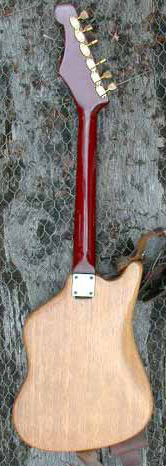

What gives? Well, in the case of the Esquire, the three-position guitar switch is wired to provide different tonal options, just as a regular pickup selection switch does, but it achieves them in a different way. There are some single-pickup guitars, such as the Fender Esquire, that have what look like pickup select switches on them, which seems kind of unnecessary, since there's only one electric guitar pickup. When is a pickup switch not a pickup switch?
#Teisco guitar with rocker switches plus#
These require multiple movements of the guitar switch to turn one pickup off and turn another one on, which takes extra time and effort, but they do have the advantage of providing more pickup combinations on guitars with three pickups than what you'll be able to achieve with a five-position blade guitar switch on its own.įigure 4: This Bass VI has individual on/off slider switches for each pickup, plus another one wired for bass-cut Rotary guitar switches are sometimes used for pickup selection (such as on the vintage Fender Electric XII and some Paul Reed Smith models), but they're also commonly used as tone controls too, such as with the Gibson Varitone control.Įven less common than guitars equipped with rotary guitar switches are guitars with individual pushbutton on/off guitar switches, or individual on/off mini toggle or slide guitar switches (Figure 4) for activating each pickup. 3) often look like ordinary knobs, and they rotate like a volume knob does, but they actually click between different guitar switch positions when the knob is turned. Three-position blade guitar switches are wired and function similarly to a three-position toggle guitar switch, with one setting (usually with the guitar switch slid fully "forward" or towards the neck) activating the neck pickup, a middle position where both pickups are active, and a third where only the bridge pickup is turned on.įive-way blade guitar switches can be wired in a variety of ways, but the most common has the bridge pickup turned on by itself when the guitar switch is thrown all the way "down", a combination of the bridge and middle pickups in the second position, the middle pickup alone in the third (or middle) position, the middle and neck pickups together in the fourth position, and finally the neck pickup alone when the guitar switch is flipped "up" (or towards the neck) all the way. 2: A modern Stratocaster uses a 5-way blade switch Three-position guitar switches are more commonly found on two-pickup guitars, while the five-position blade guitar switch is a common feature on guitars equipped with three pickups, like the Stratocaster shown in Figure 2.įig. Externally the two guitar switches look the same, and the only way to know what you're dealing with is to click through the settings and see how many there are. These come in two common varieties - three-position guitar switches and five-position guitar switches.

Most Squier guitars and Fender guitars (and many others) use a blade style guitar switch for pickup selection. A middle guitar switch position lets you use both pickups simultaneously

This setting is marked as "Treble" on some guitars. On some guitars, this setting is marked "Rhythm." When the electric guitar switch is flipped down (away from you and towards the floor), the guitar pickup that is closest to the bridge (the bridge pickup) is activated, and the guitar neck pickup is turned off. When the guitar switch is flipped up (towards you as you're holding the guitar), the guitar pickup that is closest to the guitar's neck (the "neck pickup") is usually selected by itself. 1: The toggle switch on a Gibson SG Electric GuitarĮlectric guitar switches are usually three-position switches. Electric Guitar Switches – a Beginner's GuideĬonfused about what electric guitar switches do? We're here to helpįig.


 0 kommentar(er)
0 kommentar(er)
